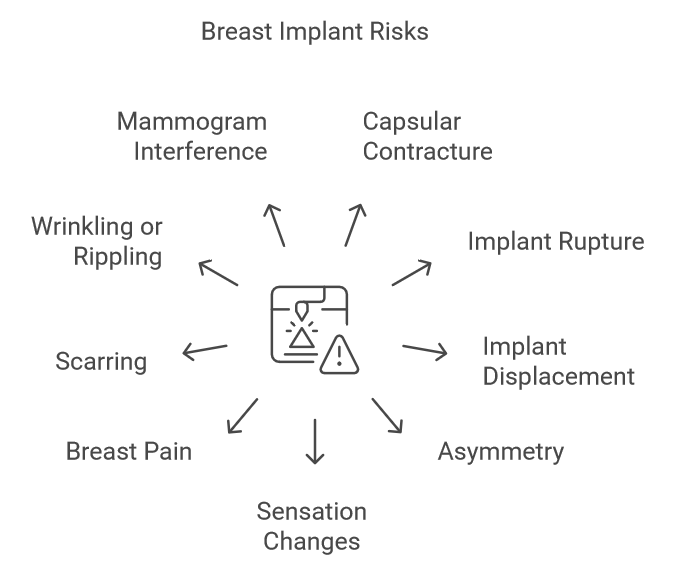
What Every Woman Needs to Know about the Risks and Complications of Breast Augmentation Surgery
If you’re considering breast augmentation surgery, you’re certainly not alone. Thousands of women in the UK choose to enhance their breasts each year, whether it’s to boost their self-confidence, restore volume lost after weight changes or pregnancy, or correct asymmetry. While the vast majority of these surgeries go smoothly and patients are thrilled with their results, it’s important that you arm yourself with knowledge about the potential risks and complications of breast augmentation before making this important decision.
Consultant Plastic Surgeon Anca Breahna has many years of experience performing different types of breast procedures, including breast augmentation surgery.
Take our Plastic Surgery Quiz to find out if you’d be a good candidate for cosmetic surgery.
Why Women Choose Breast Augmentation
Women decide to undergo breast augmentation for a variety of personal reasons. One of the most common motivations is a desire to improve self-image and boost confidence. Many women feel self-conscious about the size or shape of their breasts, and this dissatisfaction can impact their overall well-being. Breast enlargement can help these women feel more comfortable and confident in their own skin, both in and out of clothing.
Another reason women may seek breast augmentation is to correct asymmetry between the breasts. It’s quite common for women to have one breast that is noticeably larger or smaller than the other, and this unevenness can be a source of insecurity. Breast augmentation can help create a more balanced and proportionate look.
Weight fluctuations and pregnancy can also take a toll on the breasts, causing a loss of volume and changes in shape. Some women choose breast augmentation as a way to restore their breasts to their former appearance, or to achieve the fuller look they desire.
It’s important to recognise the positive impact that a successful breast enlargement can have on a woman’s life. However, while the vast majority of breast augmentation surgeries yield positive outcomes, it’s important for women to understand that no surgery is entirely risk-free. Even in the hands of a highly skilled surgeon, complications can occur. That’s why it’s so important for women to educate themselves about the potential risks and to have realistic expectations about the results of their surgery.
Download the Breast Augmentation Guide

General Surgical Risks
Breast augmentation is generally a safe procedure, but it’s important to understand that, like any surgery, it carries certain inherent risks. These risks are not unique to breast augmentation but are associated with surgery in general. It’s crucial that you are aware of these potential complications so that you can make an informed decision about whether the benefits of the procedure outweigh the risks in your particular case.
One of the primary risks of any surgery is an adverse reaction to anaesthesia. While anaesthesia is very safe for most people, some women may experience side effects such as nausea, vomiting, dizziness, or more serious complications like allergic reactions or breathing problems. Anca and her team take great care to review each patient’s medical history and current health status to minimise the risk of anaesthesia complications. However, it’s important to understand that even with these precautions, reactions can still occur.
Another potential risk of surgery is infection. Any time an incision is made in the skin, there is a chance that bacteria can enter the wound and cause an infection. Symptoms of infection may include redness, swelling, pain, discharge from the incision, and fever. While infections can usually be treated with antibiotics, in some cases, more serious complications can occur, such as the formation of an abscess or sepsis (a severe, life-threatening response to infection).
To minimise the risk of infection, Anca and her team adhere to strict sterile protocols during surgery. The operating room is thoroughly cleaned and disinfected, and all surgical instruments are sterilised. Patients are also given antibiotics before and after surgery to help prevent infection. However, despite these measures, the risk of infection cannot be completely eliminated.
Bleeding and blood clots are also potential risks of any surgery. During the procedure, some bleeding is normal and expected. However, in rare cases, excessive bleeding may occur, which can lead to complications such as haematoma (a collection of blood outside of a blood vessel) or the need for a blood transfusion. Blood clots, also known as deep vein thrombosis (DVT), can form in the legs during or after surgery due to decreased mobility. If these clots break free and travel to the lungs, they can cause a potentially life-threatening condition called pulmonary embolism (PE).
To minimise the risk of bleeding and blood clots, Anca carefully reviews each patient’s medical history and current medications to identify any factors that may increase these risks. During surgery, meticulous technique is used to control bleeding, and patients are encouraged to get up and move around as soon as possible after surgery to promote circulation and prevent clots. In some cases, compression stockings or blood-thinning medications may be prescribed to further reduce the risk of DVT and PE.
It’s important to understand that while all of these risks can be minimised through careful planning, meticulous surgical technique, and adherence to best practices, they cannot be completely eliminated.
That’s why it’s so important for patients to do their part to minimise these risks by being in the best possible health before surgery and closely following all pre- and post-operative instructions. This includes stopping smoking, achieving a stable weight, managing any chronic health conditions, and disclosing all medications and supplements to the surgical team. After surgery, it’s essential to follow guidelines for incision care, activity restrictions, and wearing any necessary support garments to promote healing and minimise complications.
Specific Risks of Breast Implants
1. Capsular Contracture
Capsular contracture occurs when the scar tissue that naturally forms around the implant hardens and squeezes the implant, causing the breast to feel firm, painful, and distorted in shape. Symptoms include hardness, pain, and visible distortion of the breast. Treatment may involve medication, implant massage, or surgery to remove the scar tissue and replace the implant. Prevention strategies include using textured implants, placing the implant under the muscle, and avoiding bacterial contamination during surgery.
2. Implant Rupture or Deflation
Implant rupture or deflation occurs when the outer shell of the implant breaks down, allowing the filling material (saline or silicone) to leak out. Symptoms of a saline implant rupture include rapid deflation of the breast, while silicone ruptures may cause no obvious symptoms (silent rupture) or may lead to pain, swelling, and changes in breast shape. Treatment involves surgical removal and replacement of the implant. Regular monitoring with imaging can help detect silent ruptures. While rupture cannot be entirely prevented, using high-quality implants and avoiding chest trauma can help minimise risk.
3. Implant Displacement or Migration
Implant displacement or migration occurs when the implant shifts from its original position, causing the breast to appear asymmetrical or misshapen. Symptoms include a change in the position of the implant, asymmetry, and discomfort. Treatment involves surgical repositioning of the implant and may require additional support such as a tissue matrix or surgical mesh. Wearing a well-fitted, supportive bra and avoiding high-impact activities can help prevent displacement.
4. Asymmetry
Asymmetry refers to a noticeable difference in the size, shape, or position of the breasts after augmentation. While some degree of asymmetry is normal, significant asymmetry can be a cosmetic concern. Symptoms include visible unevenness of the breasts. Treatment may involve surgical revision to adjust the implant size or placement. Choosing an experienced surgeon, using sizers to select appropriate implant sizes, and addressing any pre-existing asymmetry can help minimise the risk of post-operative asymmetry.
5. Changes in Nipple or Breast Sensation
Changes in nipple or breast sensation can occur after breast enlargement, including increased, decreased, or lost sensation. Symptoms may include numbness, tingling, or hypersensitivity in the nipple or breast skin. In most cases, sensation changes are temporary and resolve on their own within a few months to a year. Permanent changes are rare but can occur. Careful surgical technique to avoid damaging sensory nerves can help minimise the risk of sensation changes.
6. Breast Pain
Breast pain is a common side effect of breast augmentation, particularly in the early post-operative period. Pain may be related to surgical trauma, stretching of the tissues, or implant settling. Symptoms include aching, throbbing, or sharp pain in the breast. Pain is usually managed with oral pain medication and resolves as healing progresses. In rare cases, persistent pain may be a sign of a complication such as capsular contracture or infection and should be evaluated by the surgeon.
7. Scarring
Scarring is an inevitable result of breast augmentation surgery, as incisions are required to place the implants. However, the extent and appearance of scars can vary. Symptoms include visible, raised, or discoloured scars on the breast. Most scars will fade and flatten over time, but some may remain visible. Careful incision placement, meticulous closure technique, and diligent scar care can help minimise the appearance of scars.
8. Wrinkling or Rippling
Wrinkling or rippling refers to the appearance of visible folds or indentations on the surface of the breast, particularly in the upper or outer portions. This occurs when the implant edge or surface is palpable beneath the skin. Symptoms include a visible or palpable rippling effect on the skin. Treatment may involve changing to a different implant type (silicone instead of saline), placing the implant under the muscle, or fat grafting to camouflage the rippling. Using an appropriately sized implant and ensuring adequate soft tissue coverage can help prevent wrinkling.
9. Interference with Mammograms and Breast Cancer Detection
Breast implants can interfere with the accuracy of mammograms by obscuring some of the breast tissue, potentially making it more difficult to detect early signs of breast cancer. This does not mean that women with implants cannot undergo mammograms or that breast cancer cannot be detected, but additional specialised views (displacement views) may be necessary. It’s important for women with implants to inform their mammography technician about their implants and to undergo regular screening as recommended by their physician. Placing the implant under the muscle may help minimise interference with mammography.
FAQs about the Risks and Complications of Breast Enlargement Surgery
Can the risks and complications of breast enlargement be completely avoided?
- While the risks and complications of breast augmentation can be minimised by choosing a qualified, experienced surgeon and following all pre- and post-operative instructions carefully, they cannot be completely avoided. Every surgery carries some inherent risks, and it’s important for patients to understand and accept these risks before proceeding with the procedure.
How long do breast implants typically last, and will I need to replace them in the future?
- Breast implants are not considered lifetime devices, and most women will require replacement or revision surgery at some point. On average, breast implants last about 10-20 years, but this can vary depending on the individual and the type of implant used. Reasons for replacement may include rupture, capsular contracture, or changes in personal preferences.
Are there any long-term health risks associated with breast implants?
- While the majority of women with breast implants do not experience long-term health issues, there have been some concerns raised about potential links to certain rare conditions, such as breast implant-associated anaplastic large cell lymphoma (BIA-ALCL) and breast implant illness (BII). However, more research is needed to fully understand these potential risks, and the overall incidence remains low. It’s important to discuss any concerns with your surgeon and to stay informed about the latest research and recommendations.
What should I do if I suspect a complication after my breast augmentation surgery?
- If you experience any concerning symptoms or suspect a complication after your breast augmentation surgery, it’s important to contact your surgeon promptly. Signs to watch for may include severe pain, redness, swelling, discharge, fever, or sudden changes in breast appearance. Your surgeon will evaluate your concerns and recommend appropriate treatment, which may range from close monitoring to surgical intervention, depending on the nature and severity of the issue.
Are there any lifestyle changes I should make to minimise my risk of complications after breast augmentation?
- To minimise your risk of complications and promote optimal healing after breast augmentation, it’s important to follow your surgeon’s pre- and post-operative instructions closely. This may include stopping smoking, avoiding certain medications and supplements, maintaining a healthy diet and stable weight, and avoiding strenuous activities or high-impact exercise for a specified period. Additionally, wearing a well-fitted, supportive bra and attending all scheduled follow-up appointments can help ensure the best possible outcomes and early detection of any potential issues.
Further Reading about Breast Enlargement Surgery with Consultant Plastic Surgeon Anca Breahna
- Read more about 10 Myths Busted about Breast Augmentation and Breastfeeding
- Read more about How to Get a Natural Looking Breast Augmentation Using Smaller Implants
- Read more about Breast Augmentation Size Chart – Implant Sizes and UK Bra Cup Sizes
- Read more about Recovery Timeline after Breast Augmentation
- Read more about All about Perfect Breasts and How to Get Them
- Read more about How Breast Augmentation Can Affect Your Posture and Back
- Read more about How Can You Tell if You Have a Ruptured Breast Implant?
Medical References for Risks and Complications of Breast Enlargement Surgery
- Breast Implant Surgery: An Overview of the Risks and Health Complications
- Imaging of Breast Implant-associated Complications and Pathologic Conditions: Breast Imaging
- Imaging of breast implant and implant-associated complications: Capsular contracture and intra- or extracapsular rupture
- Prevalence of Local Postoperative Complications and Breast Implant Illness in Women With Breast Implants
- Rippling Following Breast Augmentation or Reconstruction: Aetiology, Emerging Treatment Options and a Novel Classification of Severity


 Ms Anca Breahna, PhD, MSc, FEBOPRAS, FRCS (Plast) is a highly regarded Consultant Plastic Surgeon specialising in the field of Aesthetic and Reconstructive Plastic Surgery. Anca performs a range of
Ms Anca Breahna, PhD, MSc, FEBOPRAS, FRCS (Plast) is a highly regarded Consultant Plastic Surgeon specialising in the field of Aesthetic and Reconstructive Plastic Surgery. Anca performs a range of 